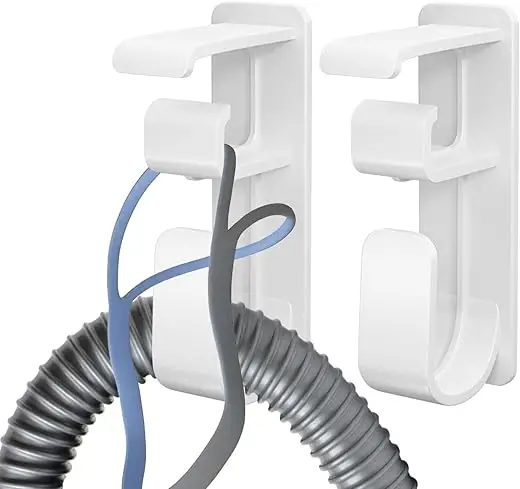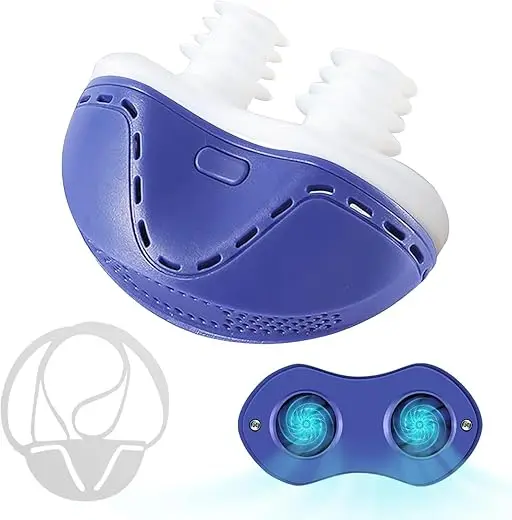The Metabolic Disaster Nobody Explains
Sleep apnea increases weight gain by 50% and makes weight loss nearly impossible. 70% of people with sleep apnea are overweight, while 40% of overweight people have sleep apnea. This creates a vicious cycle: sleep apnea causes hormonal changes that drive weight gain, while weight gain worsens sleep apnea. Studies show treating sleep apnea can lead to effortless weight loss of 10-15% in many patients.
You diet religiously, exercise when you can find energy, and the scale won’t budge—or worse, keeps climbing. Your doctor says “just lose weight” to fix your sleep apnea, but what they don’t tell you is that untreated sleep apnea makes weight loss biologically impossible for most people. This comprehensive guide reveals how sleep apnea sabotages your metabolism, why traditional weight loss fails, and how breaking this cycle transforms both conditions.
How Sleep Apnea Causes Weight Gain
The Hormonal Catastrophe
Leptin Resistance (The Satiety Hormone):
- Leptin signals fullness
- Sleep apnea causes resistance
- Brain doesn’t receive “full” signal
- Always hungry despite eating
- Levels increase but ineffective
- Weight gain inevitable
Ghrelin Surge (The Hunger Hormone):
- Ghrelin stimulates appetite
- Increases 30% with sleep apnea
- Peaks at wrong times
- Triggers carb cravings
- Nighttime eating urges
- Portion control impossible
Insulin Resistance:
- Cells don’t respond to insulin
- Blood sugar remains high
- Fat storage mode activated
- Belly fat accumulates
- Diabetes risk skyrockets
- Weight loss blocked
Cortisol Dysfunction:
- Stress hormone elevated
- Promotes fat storage
- Especially abdominal
- Muscle breakdown
- Metabolism slows
- Cravings intensify
The Metabolic Slowdown
Resting Metabolic Rate Crashes:
- Burns 15-20% fewer calories
- Even at rest
- Exercise less effective
- Diet calculations wrong
- Plateau inevitable
- Frustration builds
Thyroid Disruption:
- T3 conversion impaired
- Metabolism further slowed
- Temperature regulation affected
- Energy production decreased
- Weight gain accelerated
- Medications less effective
The Energy Crisis
Too Exhausted to Exercise:
- No energy for workouts
- Recovery impaired
- Injury risk higher
- Motivation absent
- Gym membership wasted
- Guilt compounds
NEAT Reduction: (Non-Exercise Activity Thermogenesis)
- Fidgeting decreases
- Stairs avoided
- Parking closer
- Less movement overall
- Calories not burned
- Weight creeps up
How Weight Gain Worsens Sleep Apnea
Anatomical Changes
Neck Circumference:
- Fat deposits around airway
- Every 1cm increase = 10% worse AHI
- Collar size creeps up
- Airway narrows
- Obstruction increases
- CPAP pressure needs rise
Tongue Fat:
- Tongue enlarges with weight
- Falls back easier
- Blocks airway more
- Position-dependent worsening
- Surgery less effective
Pharyngeal Fat Pads:
- Fat deposits in throat walls
- Airway compliance reduced
- Collapse threshold lower
- Snoring louder
- Apneas longer
Mechanical Factors
Abdominal Pressure:
- Belly fat pushes on diaphragm
- Lung volume reduced
- Oxygen reserve decreased
- Lying flat impossible
- Multiple pillows needed
- Positional apnea worse
Chest Wall Weight:
- Fat around chest
- Breathing effort increased
- Respiratory muscles fatigue
- Hypoventilation develops
- CO2 retention
- Oxygen drops severe
The Vicious Cycle in Action
The Downward Spiral
- Initial Weight Gain (often minor)
- Mild Sleep Apnea develops
- Hormones Disrupted (leptin/ghrelin)
- Appetite Increases uncontrollably
- Energy Crashes for activity
- More Weight Gain (accelerated)
- Sleep Apnea Worsens significantly
- Metabolism Slows further
- Depression Develops from failure
- Emotional Eating begins
- Severe OSA develops
- Morbid Obesity possible
Breaking Point Patterns
The 20-Pound Tipping Point:
- Often starts with 20-lb gain
- Mild snoring becomes apnea
- Energy drops noticeably
- Exercise stops
- Acceleration begins
The 50-Pound Disaster:
- Moderate to severe OSA
- Metabolic syndrome
- Diabetes likely
- Mobility affected
- Depression common
The 100-Pound Trap:
- Severe OSA guaranteed
- Multiple health problems
- Disability possible
- Surgery risky
- Life-threatening
Why Diets Fail with Untreated Sleep Apnea
Biological Sabotage
Calorie Restriction Backfires:
- Increases ghrelin more
- Cortisol spikes higher
- Muscle loss accelerated
- Metabolism crashes harder
- Rebound worse
- Yo-yo pattern
Exercise Doesn’t Work:
- Too exhausted to sustain
- Recovery impaired
- Cortisol prevents benefits
- Injury risk high
- Results minimal
- Motivation destroyed
Psychological Torture
Willpower Is Useless:
- Fighting biology
- Hormones win
- Guilt increases
- Self-blame severe
- Depression worsens
- Giving up inevitable
Weight Loss Medications and Sleep Apnea
GLP-1 Agonists (Ozempic, Wegovy)
Benefits:
- Weight loss significant
- May improve OSA
- Appetite controlled
- Metabolic improvement
Concerns:
- Expensive
- Side effects
- Rebound if stopped
- Doesn’t fix OSA directly
- Still need CPAP
Traditional Diet Pills
Problems:
- Stimulants worsen sleep
- Minimal effectiveness
- Side effects severe
- Rebound weight gain
- Don’t address cause
Bariatric Surgery
Considerations:
- OSA increases surgical risk
- May not cure OSA
- 30% still need CPAP
- Requires OSA treatment first
- Not first-line treatment
The Solution: Treating Sleep Apnea First
Why CPAP Leads to Weight Loss
Hormonal Restoration:
- Leptin sensitivity returns
- Ghrelin normalizes
- Insulin sensitivity improves
- Cortisol rhythm restored
- Thyroid function better
- Metabolism recovers
Energy Returns:
- Exercise possible again
- NEAT increases naturally
- Activities resumed
- Motivation returns
- Depression lifts
- Life engagement
Typical Weight Loss Timeline with CPAP
Month 1:
- Energy improving
- Cravings decreasing
- Night eating stops
- Mood better
Month 2-3:
- Weight loss begins (5-10 lbs)
- Exercise started
- Appetite normalizing
- Clothes looser
Month 4-6:
- 10-20 lbs lost
- Exercise routine established
- Eating patterns healthy
- Confidence building
Month 7-12:
- 20-40 lbs possible
- Metabolism restored
- Lifestyle transformed
- OSA improving
Year 2+:
- Sustained weight loss
- OSA may resolve
- Health transformed
- Life reclaimed
Integrated Weight Management Approach
Phase 1: Stabilization (Month 1)
Priority: Start CPAP
- Focus on compliance
- Don’t diet yet
- Let hormones adjust
- Track energy
- Gentle movement only
Phase 2: Foundation (Month 2-3)
Add Structure:
- Regular meal times
- Protein prioritization
- Hydration focus
- Light exercise
- Sleep optimization
Phase 3: Active Loss (Month 4-6)
Implement Changes:
- Moderate calorie deficit
- Strength training
- Cardio added
- Stress management
- Support system
Phase 4: Maintenance (Ongoing)
Sustain Success:
- Consistent CPAP use
- Regular exercise
- Balanced eating
- Weight monitoring
- Regular check-ups
Specific Diet Strategies for OSA
Anti-Inflammatory Approach
Foods to Emphasize:
- Omega-3 rich fish
- Colorful vegetables
- Berries
- Nuts and seeds
- Olive oil
- Green tea
Foods to Limit:
- Processed foods
- Sugar
- Refined carbs
- Excessive dairy
- Alcohol
- Late-night eating
Timing Matters
Meal Schedule:
- Early dinner (3 hours before bed)
- No night eating
- Protein at breakfast
- Regular timing
- Avoid skipping meals
- Light evening
Exercise with Sleep Apnea
Starting Safely
Begin With:
- Walking 10 minutes
- Morning movement
- Stretching
- Yoga
- Swimming
- Strength training
Avoid Initially:
- High intensity
- Late exercise
- Exhausting workouts
- Competition
- Unrealistic goals
Building Gradually
Progression:
- Week 1-2: 10 min daily
- Week 3-4: 15 min daily
- Month 2: 20 min + strength
- Month 3: 30 min varied
- Month 4+: Full routine
Success Stories
Robert, 45
“Gained 80 lbs over 10 years. Tried everything. Severe OSA diagnosis. Six months on CPAP: lost 45 lbs without dieting. Energy to exercise returned. Year later: 70 lbs down, OSA mild.”
Jennifer, 38
“Doctor said lose weight to fix sleep apnea. Impossible! Started CPAP, weight started dropping. 30 lbs in 4 months. First time weight loss worked. OSA from severe to moderate.”
Michael, 52
“Diabetic, 320 lbs, severe OSA. CPAP changed everything. Lost 100 lbs in 18 months. Off diabetes meds. OSA resolved. New person.”
Special Considerations
Women and Weight
Unique Challenges:
- Hormonal complexity
- PCOS connection
- Menopause effects
- Thyroid issues
- Social pressures
Solutions:
- Address OSA first
- Hormone evaluation
- Patience required
- Support essential
- Medical team
Weight Loss Plateau
Breaking Through:
- Check CPAP data
- Adjust pressure
- Review medications
- Stress assessment
- Sleep quality check
- Patience
Red Flags
Seek Help If:
Weight-Related:
- Gaining despite CPAP
- Rapid weight gain
- Swelling/edema
- Mobility issues
- Eating disorders
OSA-Related:
- Pressure needs increasing
- Symptoms returning
- Weight loss too rapid
- Other symptoms
- Medication interactions
Your Action Plan
Week 1: Assessment
- Document weight history
- Track eating patterns
- Note energy levels
- Identify OSA symptoms
- Schedule appointments
Week 2-4: Diagnosis
- Complete sleep study
- Metabolic panel
- Hormone testing
- Start CPAP if indicated
- Don’t diet yet
Month 2-3: Foundation
- Establish CPAP routine
- Regular meal times
- Gentle movement
- Track progress
- Build support
Month 4-6: Transformation
- Add exercise gradually
- Optimize nutrition
- Monitor both conditions
- Celebrate progress
- Adjust as needed
The Bottom Line
The “just lose weight” advice for sleep apnea is backwards. Untreated sleep apnea makes weight loss nearly impossible through hormonal sabotage, metabolic destruction, and energy depletion. Treating sleep apnea first restores your body’s ability to lose weight naturally.
Stop blaming yourself for weight loss failure. It’s not about willpower or motivation—it’s about oxygen and hormones. Fix your breathing, and your weight will follow.
The cycle can be broken:
- Treat sleep apnea → hormones normalize → weight loss possible → OSA improves → further weight loss → potential OSA resolution
Your weight struggle might end not with another diet, but with a CPAP machine. Treatment for sleep apnea could be the weight loss solution you’ve searched for your entire life.
If you can’t lose weight despite trying everything, get tested for sleep apnea. The answer to your weight struggle might be hiding in your sleep.



